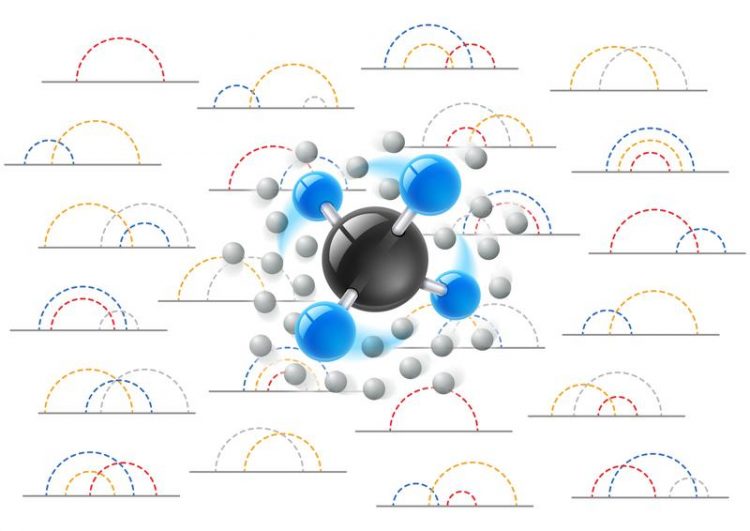Description of rotating molecules made easy

Feynman diagrams can now be used to describe rotating molecules in solvents. IST Austria/Birgit Rieger
Feynman diagrams are a powerful tool in condensed matter physics. By turning highly complex equations into sets of simple diagrams, the method has established itself as one of the sharpest tools in a theoretical physicist’s toolbox.
Giacomo Bighin, a postdoc in the group of Mikhail Lemeshko at the Institute of Science and Technology Austria (IST Austria), has now extended the Feynman diagram technique: originally devised for subatomic particles, the simplest objects imaginable, the technique can now work with molecules, far more complex objects.
The research, which was published in the journal “Physical Review Letters”, is expected to drastically simplify the description of molecular rotations in solvents. This brings scientists one step closer to their long-term goal of understanding chemical reactions in solvents at the microscopic level and, potentially, controlling them.
Sometimes when you’re stuck on a problem, the solution could be closer than you think, for instance in a different area of the research field you are working in. But thinking across disciplines is difficult and requires a good mix of expertise and an environment that fosters such interdisciplinary collaborations.
Giacomo Bighin found such an environment at IST Austria when he, a condensed matter physicist, joined the group of Mikhail Lemeshko, a molecular physicist. The result is a new method for molecular physics, one that can greatly facilitate the description of rotating molecules in solvents and paves the way for eventually controlling their reactions.
“Molecules always rotate, and how they interact with one another depends on their relative orientation. That is, if they hit another molecule with one end, it has a different effect than if they hit it with the other end,” explains Mikhail Lemeshko.
The orientation of molecules and hence chemical reactions have already been controlled in experiments on molecular gases, but it is quite challenging to do the same in solvents.
This is a long-term goal that Mikhail Lemeshko and his group are working towards, one step at a time. The step they have just taken is about being better able to describe the rotation of a molecule in a solvent—a prerequisite for eventually controlling reactions in this environment.
Transferring the method, however, was not easy. “Feynman diagrams work for point-like particles such electrons. Point-like means that they are not affected by rotations: if you rotate an electron, it looks exactly the same as before.
Molecules, on the other hand, are more complex and can rotate and change their orientation in space” explains Giacomo Bighin. In order to transfer the method from electrons to molecules, he had to develop a new formalism. Previously, it was not known if it would even work for molecules, and adapting the method took Bighin more than a year.
Now the formalism is ready to use in chemical problems. “We expect that people from a more molecular background will see that it is now possible to study molecules in this way. The technique delivers extremely precise results in condensed matter physics, and it has the potential to achieve the same accuracy in molecular simulations,” Lemeshko adds.
About IST Austria
The Institute of Science and Technology (IST Austria) is a PhD-granting research institution located in Klosterneuburg, 18 km from the center of Vienna, Austria. Inaugurated in 2009, the Institute is dedicated to basic research in the natural and mathematical sciences. IST Austria employs professors on a tenure-track system, postdoctoral fellows, and doctoral students. While dedicated to the principle of curiosity-driven research, the Institute owns the rights to all scientific discoveries and is committed to promote their use. The first president of IST Austria is Thomas A. Henzinger, a leading computer scientist and former professor at the University of California in Berkeley, USA, and the EPFL in Lausanne, Switzerland. The graduate school of IST Austria offers fully-funded PhD positions to highly qualified candidates with a bachelor's or master's degree in biology, neuroscience, mathematics, computer science, physics, and related areas. http://www.ist.ac.at
Mikhail Lemeshko
Institute of Science and Technology Austria (IST Austria)
mikhail.lemeshko@ist.ac.at
G. Bighin, T. V. Tscherbul, and M. Lemeshko: “Diagrammatic Monte Carlo Approach to Angular Momentum in Quantum Many-Particle Systems”, Phys. Rev. Lett. 121, 165301, DOI: 10.1103/PhysRevLett.121.165301
https://journals.aps.org/prl/abstract/10.1103/PhysRevLett.121.165301
https://ist.ac.at/en/research/research-groups/lemeshko-group/ Website of the research group
Media Contact
All latest news from the category: Interdisciplinary Research
News and developments from the field of interdisciplinary research.
Among other topics, you can find stimulating reports and articles related to microsystems, emotions research, futures research and stratospheric research.
Newest articles

Innovative 3D printed scaffolds offer new hope for bone healing
Researchers at the Institute for Bioengineering of Catalonia have developed novel 3D printed PLA-CaP scaffolds that promote blood vessel formation, ensuring better healing and regeneration of bone tissue. Bone is…

The surprising role of gut infection in Alzheimer’s disease
ASU- and Banner Alzheimer’s Institute-led study implicates link between a common virus and the disease, which travels from the gut to the brain and may be a target for antiviral…

Molecular gardening: New enzymes discovered for protein modification pruning
How deubiquitinases USP53 and USP54 cleave long polyubiquitin chains and how the former is linked to liver disease in children. Deubiquitinases (DUBs) are enzymes used by cells to trim protein…



